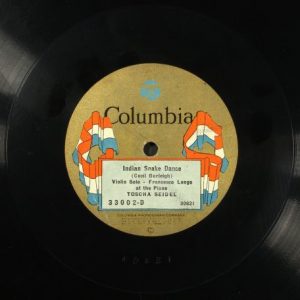Using the search term “Burleigh” in the Library of Congress’s National Jukebox archive, what was initially meant to yield results pertaining to H.T. Burleigh presented a search result far more interesting to me: a recording of a piece titled “Indian Snake Dance” by Cecil Burleigh. The recording captured Toscha Seide on Violin and Francesco Longo on Piano (1). The record is shown in the picture below (2).
Almost immediately after finding this recording, the question of authenticity and cultural representation came to mind. As a student in this class with prior musicology experience, this piece screams cultural appropriation and misrepresentation. The piano accompaniment for the main theme is a misguided attempt to imitate the sound of the drum in Native American pow-wow music. The violin attempts to mimic voices, dancing around the beat, similar to how a western trained ear might perceive Native American singing. However, rhythmic subdivisions in the violin are too clean. This in combination with the low 5ths in the left hand creates a caricature that mocks its original source. Beyond its initial theme, it abandons its facade of representing Native American culture and adheres to its western classical musical heritage for the rest of the piece.
What’s ultimately disappointing about this recording and database entry is the lack of context surrounding it. Not everyone listening to this will have attended higher education institutions, let alone studied musicology. Those who don’t have the same background knowledge have to rely on the information provided on the page. The hyperlinks included in the entry are simply labels that pull up more loosely related content, and if you click on the composer’s name, you’ll find that “Indian Snake Dance” is his only recording in the database. There are no liner notes, no information about the piece. It was only through my own independent research that it became abundantly clear that Cecil Burleigh has no apparent cultural ties to Native Americans. He was immersed in western classical music, studying at Klindworth-Scharwenka Conservatory in Berlin, the Chicago Musical College, and playing violin professionally (3).
If these materials like “Indian Snake Dance” -from relatively unknown authors- are made easily accessible to the general public, one would hope there could be more context surrounding these recordings. Those unlike myself, unwilling to do independent research, will lack the understanding required to explore the questions of authenticity beneath the surface level of this piece.
(1) Burleigh, Cecil, Toscha Seidel, and Francesco Longo. Indian Snake Dance. 1923. Audio. https://www.loc.gov/item/jukebox-670039/.
(2) Burleigh, Cecil, Toscha Seidel, and Francesco Longo. Indian Snake Dance. 1923. Audio. https://www.loc.gov/item/jukebox-670039/.
(3) Lowens, Margery Morgan. “Burleigh, Cecil.” Grove Music Online. 23 Feb. 2011; Accessed 8 Nov. 2022. https://www.oxfordmusiconline.com/grovemusic/view/10.1093/gmo/9781561592630.001.0001/omo-9781561592630-e-1002092891.

